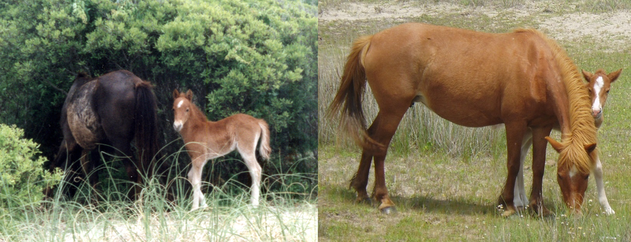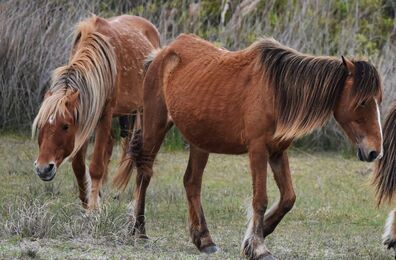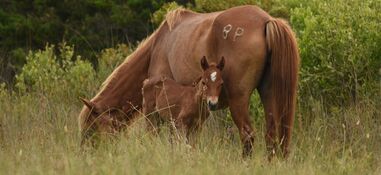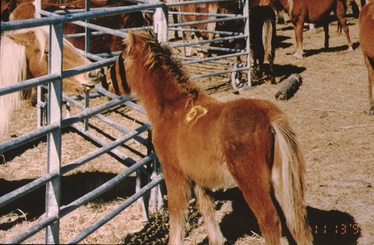Behavioral ecology and physiology
 Left, mare and her adopted offspring. Right, the adopted offspring as an adult with her second foal.
Left, mare and her adopted offspring. Right, the adopted offspring as an adult with her second foal.
Adoption in the wild
Researchers rarely witness adoption in wild animals, leaving us with a very limited understanding of how adults care for adopted offspring. I was lucky enough to track a case of adoption by a feral mare at my field site on Shackleford Banks, a barrier island off the coast of North Carolina, USA. What made my study even more unique was that I was able to conduct a detailed comparison of the care the mare afforded both her adopted and genetic offspring (born the previous year). While theory would suggest that the adopted offspring might receive less parental care than the genetic offspring, for the most part, the mare treated these foals equally. She maintained contact with both foals to a similar degree, allowed them to suckle for an equivalent amount of time, exhibited the same degree of aggression during suckling, and terminated suckling with similar frequency. None of the hypotheses often posed to explain adoption in wild animals adequately explain this case; begging the question, given the high physiological costs of raising a foal to maturity, why did this mare adopt? It would seem that mare and foal were both in the right place at the right time: the mare had recently lost her newborn foal of that year, and the foal she adopted had been abandoned by her biological mother only days before. The likelihood that two such events will occur in close proximity (in both space and time) is lower in the wild than in domestic conditions and may account, at least in part, for the rarity of adoption in wild species.
Nuñez, C.M.V., J.S. Adelman, and D.I. Rubenstein. 2013. A free-ranging, feral mare (Equus caballus) affords similar maternal care to her genetic and adopted offspring. American Naturalist, 182:674-681.
Researchers rarely witness adoption in wild animals, leaving us with a very limited understanding of how adults care for adopted offspring. I was lucky enough to track a case of adoption by a feral mare at my field site on Shackleford Banks, a barrier island off the coast of North Carolina, USA. What made my study even more unique was that I was able to conduct a detailed comparison of the care the mare afforded both her adopted and genetic offspring (born the previous year). While theory would suggest that the adopted offspring might receive less parental care than the genetic offspring, for the most part, the mare treated these foals equally. She maintained contact with both foals to a similar degree, allowed them to suckle for an equivalent amount of time, exhibited the same degree of aggression during suckling, and terminated suckling with similar frequency. None of the hypotheses often posed to explain adoption in wild animals adequately explain this case; begging the question, given the high physiological costs of raising a foal to maturity, why did this mare adopt? It would seem that mare and foal were both in the right place at the right time: the mare had recently lost her newborn foal of that year, and the foal she adopted had been abandoned by her biological mother only days before. The likelihood that two such events will occur in close proximity (in both space and time) is lower in the wild than in domestic conditions and may account, at least in part, for the rarity of adoption in wild species.
Nuñez, C.M.V., J.S. Adelman, and D.I. Rubenstein. 2013. A free-ranging, feral mare (Equus caballus) affords similar maternal care to her genetic and adopted offspring. American Naturalist, 182:674-681.
 A band stallion herds his female closer to the rest of the group.
A band stallion herds his female closer to the rest of the group.
Social environment and stress physiology
Feral horses have a complex social structure, the stability of which is important to their overall health. Behavioral and demographic research has shown that decreases in group stability reduce female fitness, but the potential effects on the physiological stress response had not been demonstrated. To fully understand how group stability affects group-member fitness, we need to understand not only behavioral and demographic, but also physiological consequences of decreases to that stability. I studied group changes in feral mares (an activity that induces instability, including both male and female aggression) on Shackleford Banks, NC. I found that mares in the midst of changing groups exhibited increased levels of fecal cortisol, the primary stress-related hormone in mammals. In addition, mares making more group transfers showed higher levels of cortisol two weeks post-behavior. These results offer insights into how social instability is integrated into an animal's physiological phenotype. In addition, my results have important implications for feral horse management. On Shackleford Banks, mares contracepted with porcine zona pellucida (PZP) have been shown to make approximately 10 times as many group changes as untreated mares. Such animals may therefore be at higher risk of chronic stress. These results support the growing consensus that links between behavior and physiological stress must be taken into account when managing for healthy, functional populations.
Nunez, C.M.V., J.S. Adelman, J. Smith, L.R. Gesquiere, and D.I. Rubenstein. 2014. Linking social environment and stress physiology in feral mares (Equus caballus): Group transfers elevate fecal cortisol levels. General and Comparative Endocrinology.
Feral horses have a complex social structure, the stability of which is important to their overall health. Behavioral and demographic research has shown that decreases in group stability reduce female fitness, but the potential effects on the physiological stress response had not been demonstrated. To fully understand how group stability affects group-member fitness, we need to understand not only behavioral and demographic, but also physiological consequences of decreases to that stability. I studied group changes in feral mares (an activity that induces instability, including both male and female aggression) on Shackleford Banks, NC. I found that mares in the midst of changing groups exhibited increased levels of fecal cortisol, the primary stress-related hormone in mammals. In addition, mares making more group transfers showed higher levels of cortisol two weeks post-behavior. These results offer insights into how social instability is integrated into an animal's physiological phenotype. In addition, my results have important implications for feral horse management. On Shackleford Banks, mares contracepted with porcine zona pellucida (PZP) have been shown to make approximately 10 times as many group changes as untreated mares. Such animals may therefore be at higher risk of chronic stress. These results support the growing consensus that links between behavior and physiological stress must be taken into account when managing for healthy, functional populations.
Nunez, C.M.V., J.S. Adelman, J. Smith, L.R. Gesquiere, and D.I. Rubenstein. 2014. Linking social environment and stress physiology in feral mares (Equus caballus): Group transfers elevate fecal cortisol levels. General and Comparative Endocrinology.
 A mare and her foal on Shackleford Banks.
A mare and her foal on Shackleford Banks.
Communication between mother and offspring
Acoustic signaling plays an important role in mother-offspring recognition and subsequent bond-formation. It remains unclear, however, if mothers and offspring use acoustic signaling in the same ways and for the same reasons throughout the juvenile stage, particularly after mutual recognition has been adequately established. Moreover, despite its critical role in mother-offspring bond formation, research explicitly linking mother-infant communication strategies to offspring survival are lacking. We examined the communicative patterns of mares and their foals to better understand 1) the nature of mother-offspring communication throughout the first year of development; 2) the function(s) of mother- vs. offspring-initiated communication and; 3) the importance of mare and foal communication to offspring survival. We found that 1) mares and foals differ in when and how they initiate communication; 2) the outcomes of mare- vs. foal-initiated communication events consistently differ; and 3) the communicative patterns between mares and their foals can be important for offspring survival to one year of age. Moreover, given the importance of maternal activity to offspring behavior and subsequent survival, we submit that our research is uniquely positioned to address the long-debated question: do the behaviors exhibited during the juvenile stage (by both mothers and their young) confer delayed or immediate benefits to offspring?
Nuñez, C.M.V. and D.I. Rubenstein. 2020. Communication is key: Mother-offspring signaling can affect behavioral responses and offspring survival in feral horses (Equus caballus). PLOS ONE 15(4), e0231343.
Acoustic signaling plays an important role in mother-offspring recognition and subsequent bond-formation. It remains unclear, however, if mothers and offspring use acoustic signaling in the same ways and for the same reasons throughout the juvenile stage, particularly after mutual recognition has been adequately established. Moreover, despite its critical role in mother-offspring bond formation, research explicitly linking mother-infant communication strategies to offspring survival are lacking. We examined the communicative patterns of mares and their foals to better understand 1) the nature of mother-offspring communication throughout the first year of development; 2) the function(s) of mother- vs. offspring-initiated communication and; 3) the importance of mare and foal communication to offspring survival. We found that 1) mares and foals differ in when and how they initiate communication; 2) the outcomes of mare- vs. foal-initiated communication events consistently differ; and 3) the communicative patterns between mares and their foals can be important for offspring survival to one year of age. Moreover, given the importance of maternal activity to offspring behavior and subsequent survival, we submit that our research is uniquely positioned to address the long-debated question: do the behaviors exhibited during the juvenile stage (by both mothers and their young) confer delayed or immediate benefits to offspring?
Nuñez, C.M.V. and D.I. Rubenstein. 2020. Communication is key: Mother-offspring signaling can affect behavioral responses and offspring survival in feral horses (Equus caballus). PLOS ONE 15(4), e0231343.
 A mare and her six month old foal, separated during a gather of the Shackleford Banks horse population in 1996.
A mare and her six month old foal, separated during a gather of the Shackleford Banks horse population in 1996.
Sociality and juvenile survival
In several social species, the associations formed by adult individuals have been linked to individual fitness. Less is known about the associations made by offspring and the mechanisms by which such associations might influence fitness. I investigated the effects of sociality on juvenile survival in the feral horse. I used foal degree, the number of foal associates, to assess the importance of sociality to survival after a catastrophic event, the gathering and removal of 40% of the horse population. My results add to our understanding of the benefits afforded by juvenile social networks. With such information, we can institute management strategies that encourage minimal disturbance of species’ social structure. Finally, my study is unique in that foals were separated from parental support at a crucial point in development. Therefore, I was able to separate the effects of parental behavior on juvenile sociality, allowing me to more directly ask the question: do the behaviors exhibited by young mammals confer immediate and/or future benefits?
Nuñez, C.M.V., J.S. Adelman, D.I. Rubenstein. 2015. Sociality increases juvenile survival after a catastrophic event in the feral horse (Equus caballus). Behavioral Ecology, 26(1), 138–147.
In several social species, the associations formed by adult individuals have been linked to individual fitness. Less is known about the associations made by offspring and the mechanisms by which such associations might influence fitness. I investigated the effects of sociality on juvenile survival in the feral horse. I used foal degree, the number of foal associates, to assess the importance of sociality to survival after a catastrophic event, the gathering and removal of 40% of the horse population. My results add to our understanding of the benefits afforded by juvenile social networks. With such information, we can institute management strategies that encourage minimal disturbance of species’ social structure. Finally, my study is unique in that foals were separated from parental support at a crucial point in development. Therefore, I was able to separate the effects of parental behavior on juvenile sociality, allowing me to more directly ask the question: do the behaviors exhibited by young mammals confer immediate and/or future benefits?
Nuñez, C.M.V., J.S. Adelman, D.I. Rubenstein. 2015. Sociality increases juvenile survival after a catastrophic event in the feral horse (Equus caballus). Behavioral Ecology, 26(1), 138–147.
